Building a strong bottom line and gaining a competitive edge relies on cutting costs as much as growing revenue. Optimizing purchase order approval processes provides one of the fastest and easiest ways to cut costs.
In this article, we’ll do a deep dive into the purchase order approval process and how you can automate it to save your business significant time and money.
What is Purchase Order Approval?
Purchase order approval is the process of relevant stakeholders in a company reviewing and approving or rejecting business purchases before they are placed with a vendor.
Who needs to approve a purchase is defined in the company purchase order policy. This will normally depend on the type of items being purchased, which department it relates to, and the overall value of the purchase.
At most companies, purchase orders (POs) must go through an internal approval process before they get sent to the vendor. This process can involve several reviewers looking over the purchase order and giving their stamp of approval. They will evaluate questions such as:
- Is this purchase within our budget?
- Is this an approved vendor?
- Is this our preferred vendor for these items?
- Are these goods or services necessary for our company?
- Is there a lower-cost or higher-quality alternative?
- Are there any errors or mistakes on this purchase order that need to be corrected?
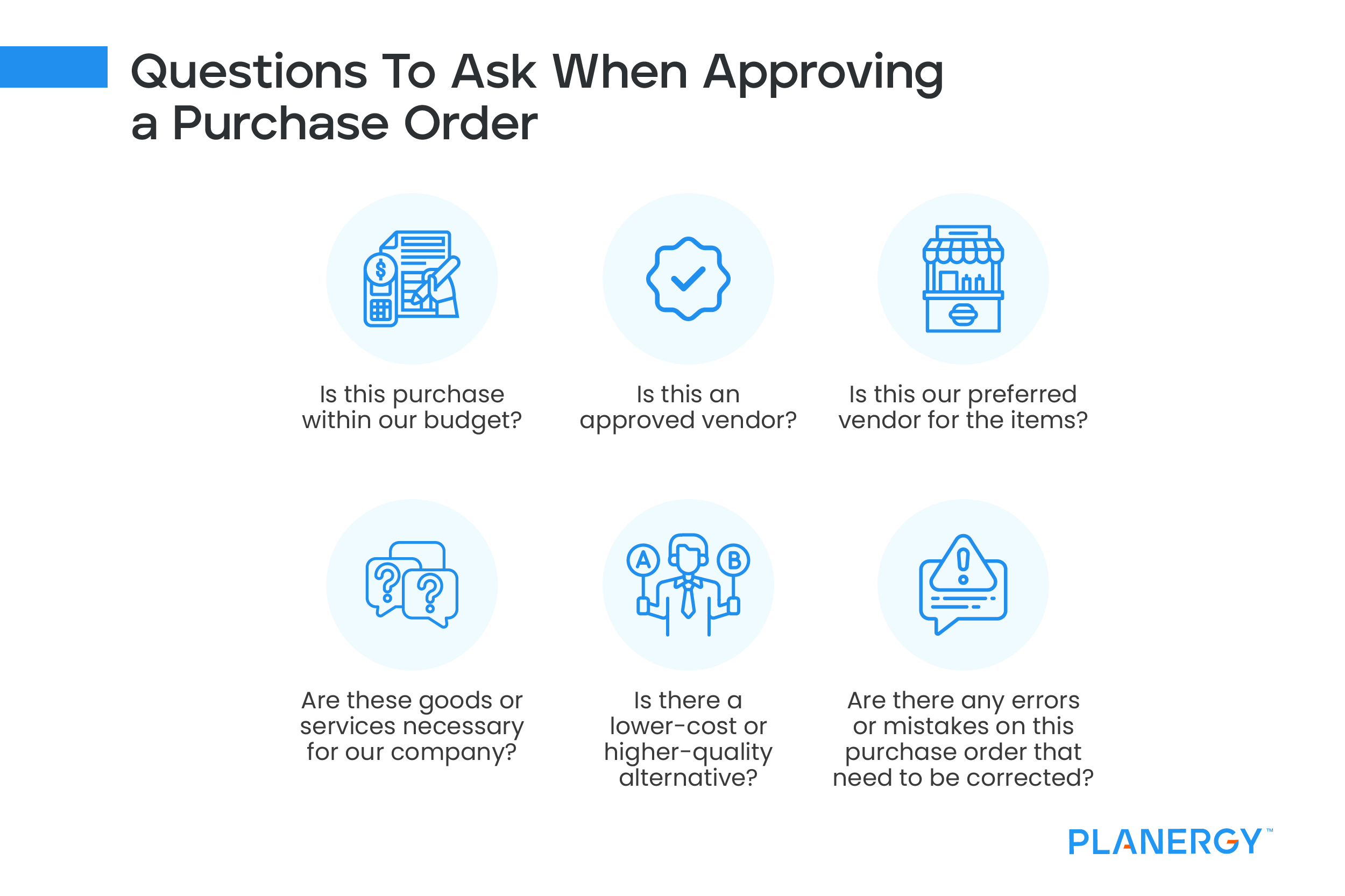
Because a purchase order becomes a legally binding contract once it’s received and accepted by the vendor, it’s important that companies review these types of questions before sending it out. It also gives them a chance to ensure that budgets are followed and only smart purchases are made.
Who Approves Purchase Orders in a Company?
Companies will assign employees within various departments to approve purchase orders. Depending on their role, these approvers will either be looking at the budget and need, or the correctness of the purchase order.
Budget approvers are most likely going to be department managers or project managers who are in charge of making and tracking budgets. They will ensure that the company has funds for the PO in their budget and that this is a purchase that the team truly needs to make.
Procurement team reviewers will want to ensure that vendor provides goods and services for a fair price and high quality compared to alternatives. They will also check the budget to make sure funds are available and review the pricing terms and payment information.
Department managers will review purchase orders to make sure they fit the budget and are needed. Procurement teams will review them to ensure a fair market price, high quality of goods and services, and that there are no errors on the PO.
What Are the Benefits of Approving Purchase Orders?
Putting purchase orders through an approval process provides several key benefits and advantages to any organization. These benefits include:
Better Budgeting
Ensuring that POs go through an approval process gives companies a chance to check their budgets before approving spending. This helps budget holders to have better control over their budgets.
Spend Visibility
With approval processes in place staff cannot buy things without oversight. Accountability results in better buying behavior and also enables senior management to analyze spend more easily.
Cost Savings
The approver’s main job is to check that purchase requests are for valid purchases that support the company’s goals. By stopping unnecessary purchases, they are saving money for purchases that matter.
Higher Quality Goods and Services
Approvers will also make sure that the vendor that’s being requested is reputable. By stopping purchases from vendors with a bad reputation, companies will ensure that they are getting higher quality goods and services and not wasting their money.
Easier Audits
Having records of approved purchases makes audits easier. Teams can show that every dollar spent was approved and who approved it, which makes it much easier to comply when auditors start asking questions.
Long-term Sustainability
If a company allows excess purchases or the repeated use of poor-performing vendors, the negative costs are going to add up and hurt the company over time. When every purchase is properly vetted, companies have a better chance of staying financially stable for a longer time.
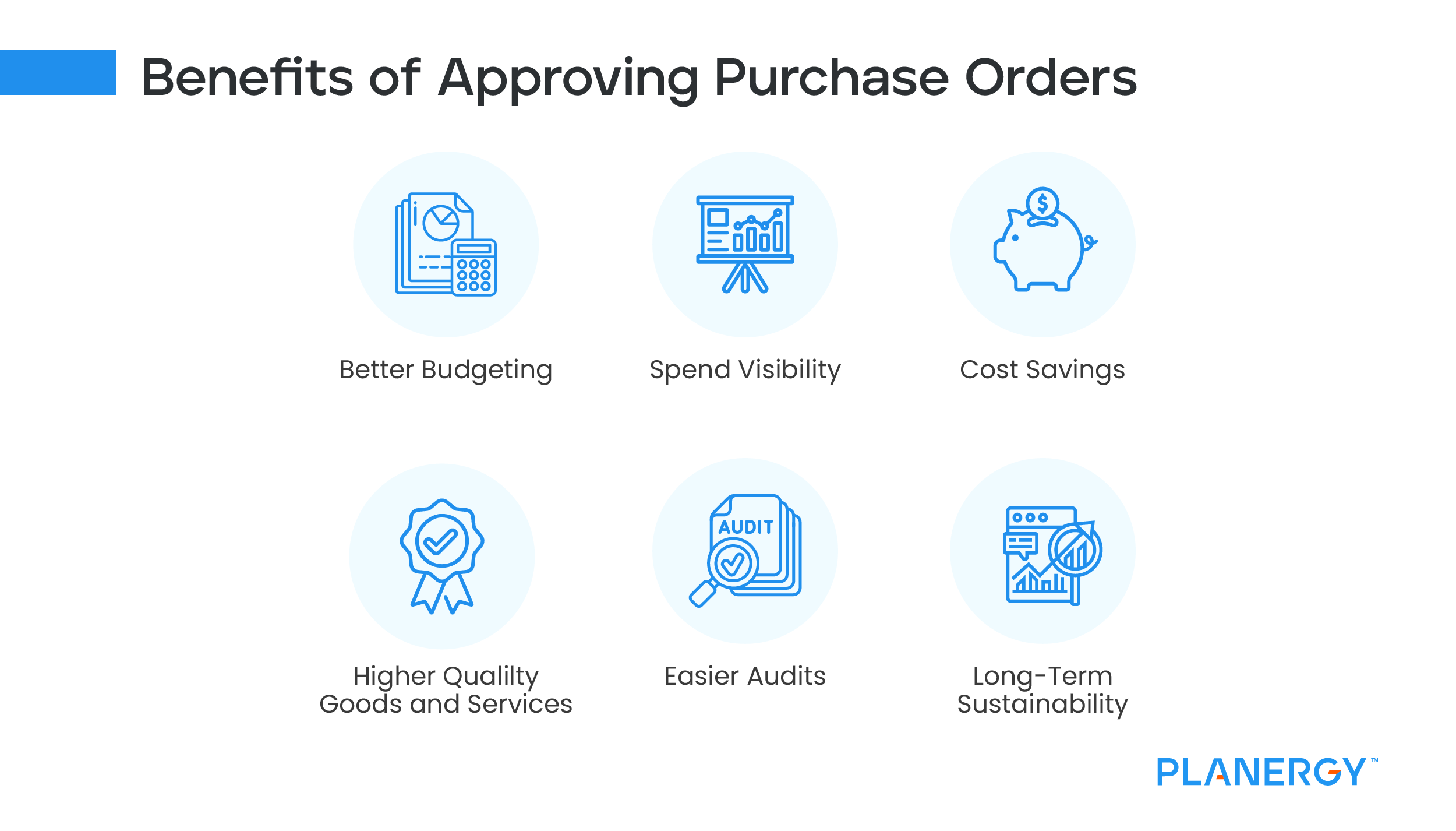
What Is the Approval Process for Purchase Orders?
Every company has its own unique purchase order review process that fits within its larger procure-to-pay cycle. However, the average purchase order approval workflow is likely to look like this:
Internal Needs Review
The individual or department in need of goods or services submits a purchase requisition to the approving party (e.g. their supervisor or manager).
The approving party then reviews their request and, if approved, it’s sent to the purchasing department. The request may require multiple approvals if it’s for higher-priced goods and services.
Procurement Review
The request is reviewed by a procurement team member to ensure accurate information, formatting, and compliance with policy, procedure, and legal requirements.
The procurement team also verifies whether the requesting party’s budget can support the purchase and whether or not the purchase is from an approved vendor.
For new vendors, they will want to vet them to ensure that they are charging fair market prices and providing high-quality goods and services.
If they find something wrong with the vendor, they may not approve the purchase order and suggest the requestor go with a different vendor.
Purchase Approval
Based on the information collected, budget capacity, and procedural review, the purchasing team either approves the request or rejects it.
If the purchase requisition is rejected for non-budgetary reasons (e.g., missing or incorrect information), then it may be returned to the requestor for correction and resubmission.
Purchase Order Creation
Approved purchase orders are issued a purchase order number and prepared for submission to the vendor. They include essential information related to the order, including:
- Address and contact information for both the buyer and vendor
- Quantity and description of goods (or services) ordered
- Payment information
- Payment terms
- Delivery terms
- Applicable conditions for both the order and any negotiated contractual obligations between the two parties.
Once it’s ready, the purchase order is double-checked for accuracy and then submitted to the supplier.
Vendor Approval
In order to become a legally binding contract, the purchase order must be approved by the supplier. Upon receiving the purchase order, vendors will perform their due diligence by either:
Checking for previous purchases and any existing outstanding balances (for current customers).
Or
Confirming the buyer’s contact and payment information, and, in some cases, their creditworthiness (for new customers).
Once the vendor provides final approval, it becomes a legally binding agreement. If there is an issue with either delivery or payment, either side can refer to the purchase order to settle the dispute.
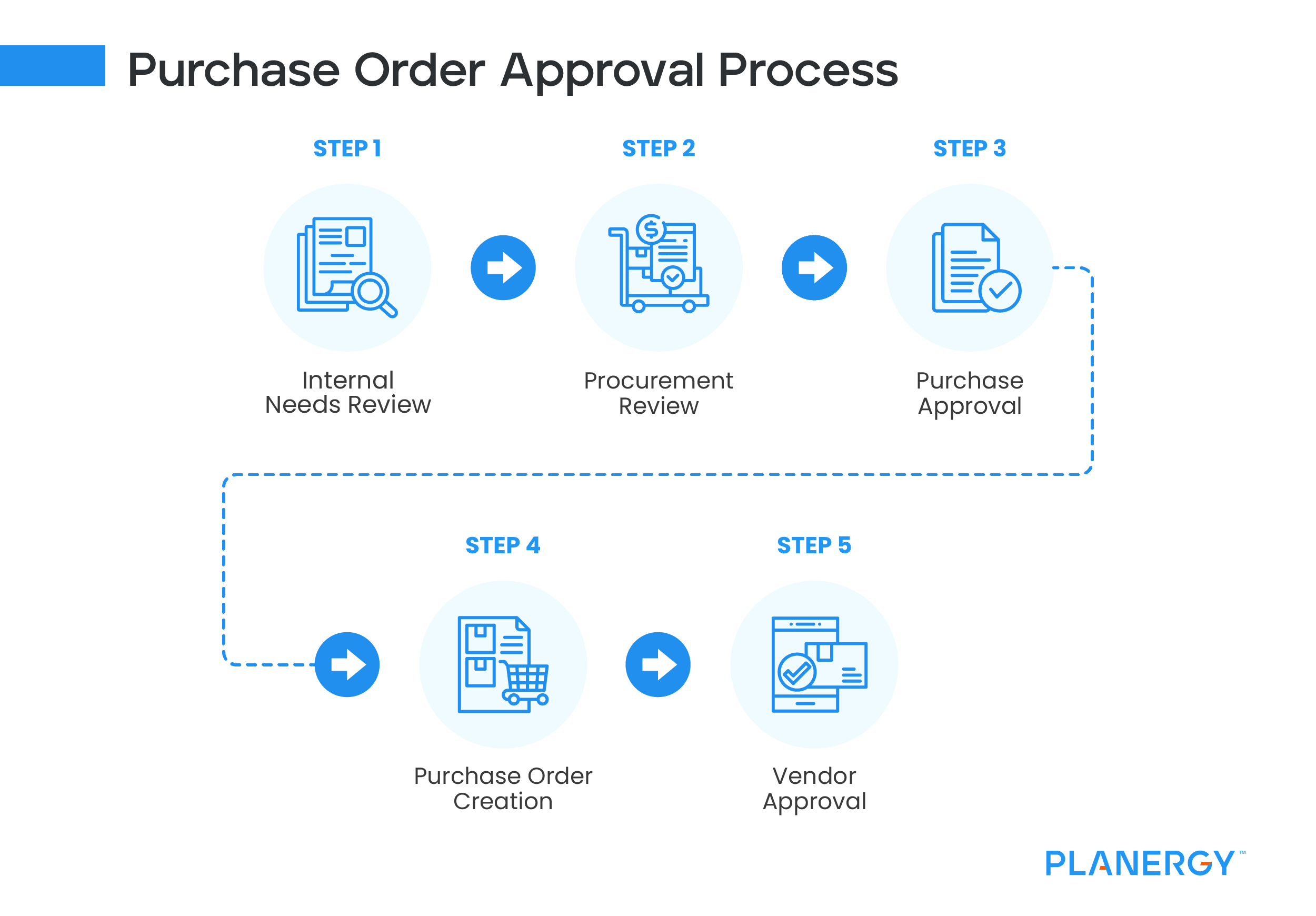
Before purchase order software, the PO approval process was time-consuming, laborious, and costly. Automation has dramatically improved the process by cutting back on costs and improving speed and accuracy.
What Are the Benefits of Automating the PO Approval Process?
Manual processes are time-consuming, costly, error-prone. Upgrading to automated purchase order software brings numerous benefits, including:
- Greater speed thanks to automatic routing to the appropriate approver.
- Fewer bottlenecks as push notifications across multiple devices remind approvers that it’s time to review the PO.
- Reduced human error with the ability to auto-populate relevant data and control access based on user roles and responsibilities.
- Improved overall productivity and efficiency by streamlining a key part of purchase order process.
- Reduced rogue spend, or maverick spend, when all purchases are automatically routed for approval.
- Less staff resources dedicated to low-value tasks like data entry and error corrections.
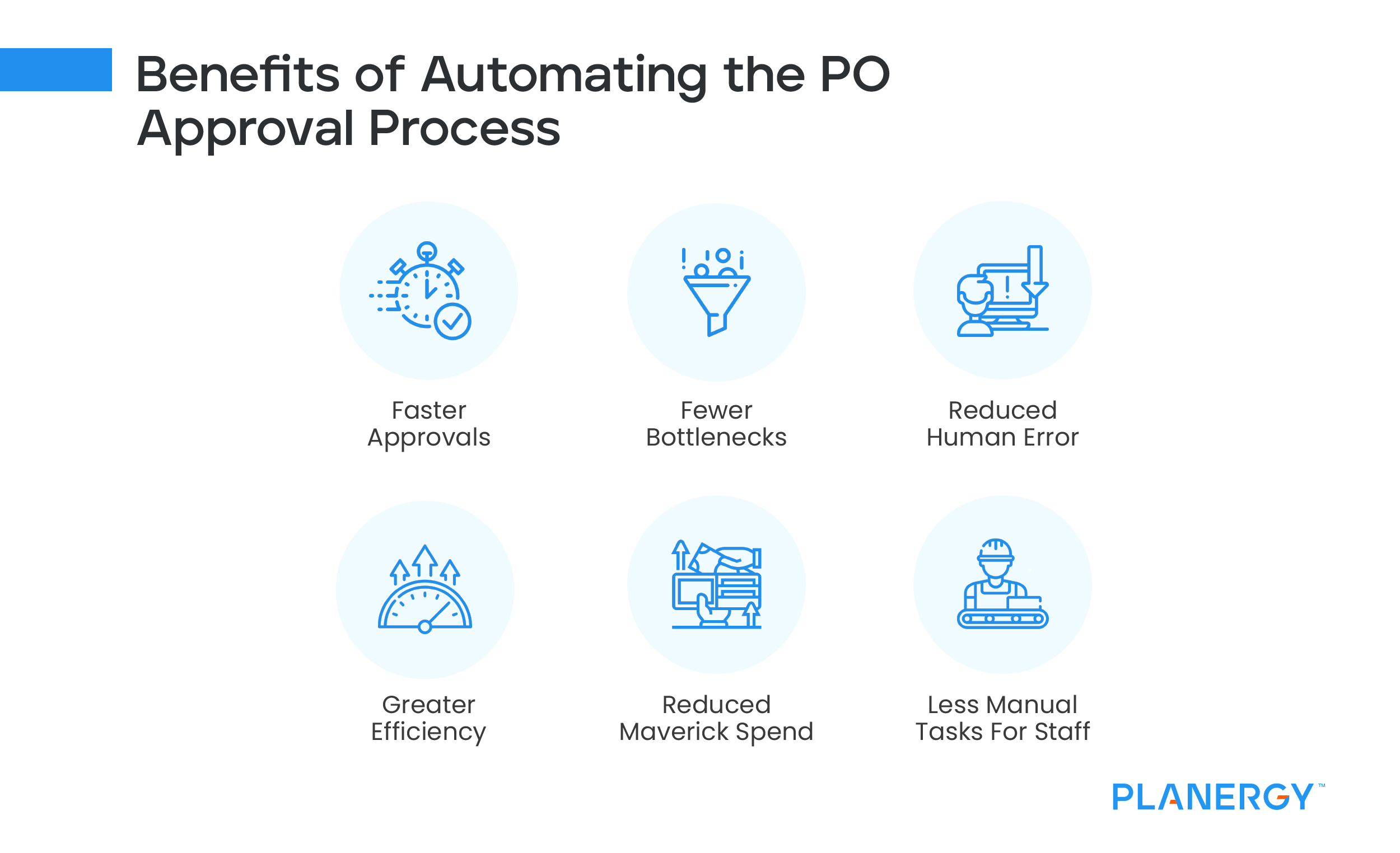
5 Best Practices for Automating Your Purchase Order Approval Process
The first step in automating the PO approval process is choosing the right purchase order software to do the job.
PLANERGY’s purchase order software integrates with your existing systems, utilizes cloud-based document and data management, and includes a mobile app for access from any device.
Once you’ve decided on your software, the next step is following seven best practices to ensure a smooth transition and greater productivity and efficiency.
Review Your Existing Purchase Order Approval Workflow
Document the journey of every purchase order, from purchase requisition on, and identify any consistent points of failure. Make note of the existing buying and approving roles for when you set up automatic approval flows later on.
Set Benchmarks for Performance, Reliability, and Efficiency
This applies to vendors, internal business practices, and your procurement team. Because you’ll have access to more financial data across your procure-to-pay process, you can use it to gain insights into your workflow and find opportunities to create efficiency, productivity, and savings.
Create Workflows to Manage One-offs
Integrate responsibilities and roles for ordering and approving unusual purchases.
Add a review template for these purchases that ensures compliance with existing policy while still allowing for discretionary purchases or reprioritization of expenditures (e.g. delaying small non-critical purchases to fund a larger more urgent one).
Provide Training and Support
Your new system will only be effective if it’s being used. Make sure everyone who uses the system has training prior to launch. Provide ongoing, real-time support for questions, and training refreshers every few months once the system is live to ensure no one is left behind.
Audit Regularly for Continuous Improvement
Going live with your automated purchasing solution is only the first step. You can continue to refine your processes by taking note of problems related to suppliers, products, or workflows and tweaking them to meet your benchmarks.
The more efficient your automated purchasing workflows are, the greater your savings.
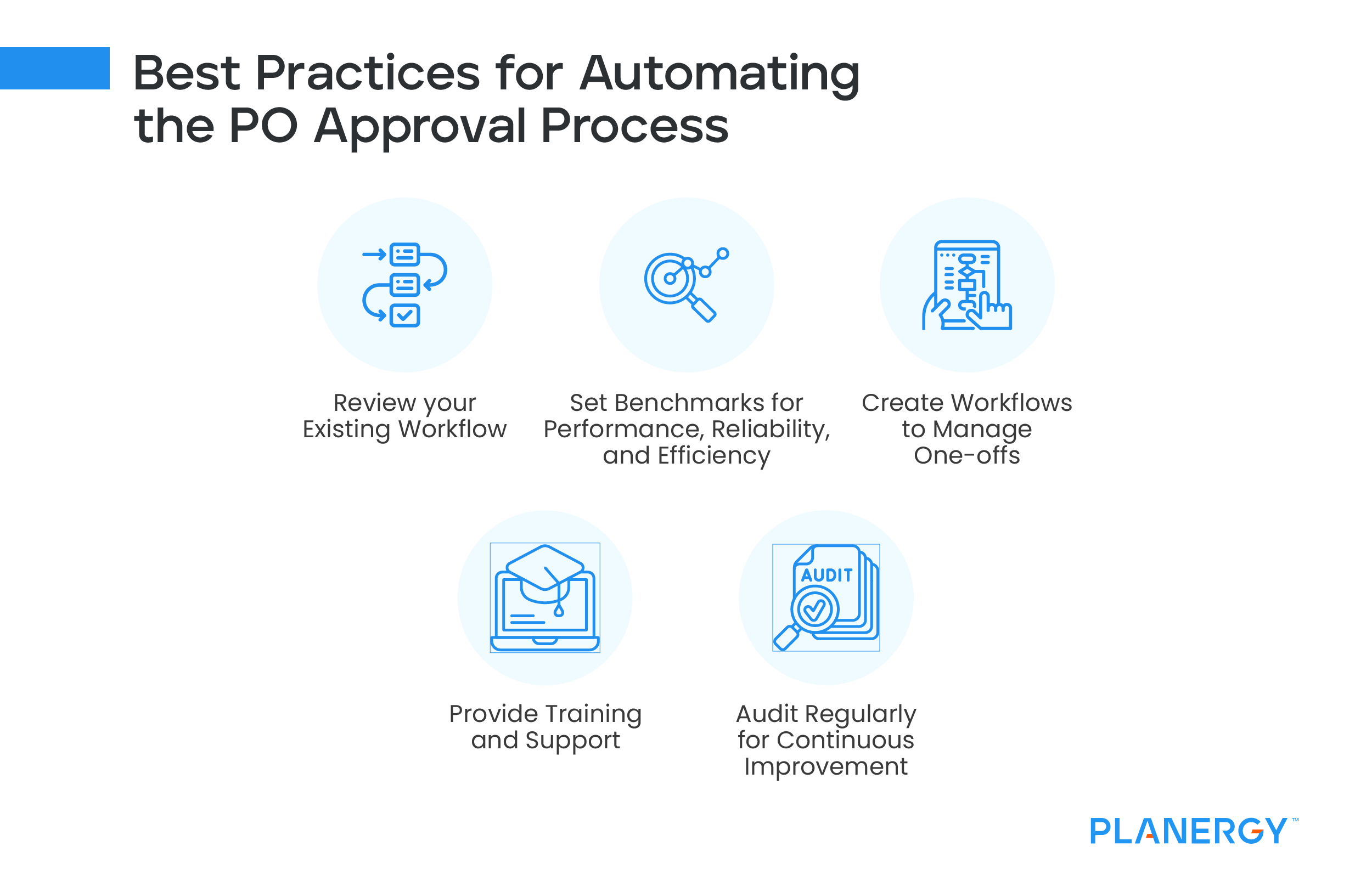
Automated Approval Workflows Create Stronger Procurement Value
Why settle for inefficient purchase order processes that waste time, labor, and resources? When you automate your procurement process, you can refine your end-to-end workflows to achieve maximum value with minimum spend—which makes a powerful impact on your business.




